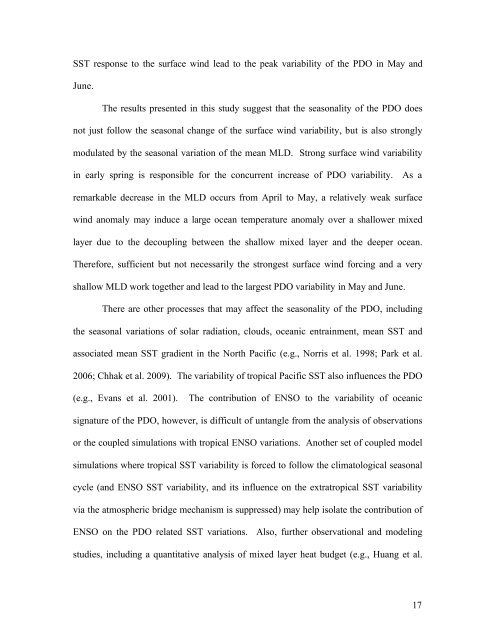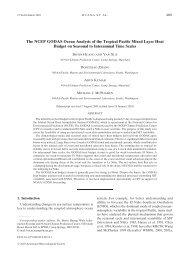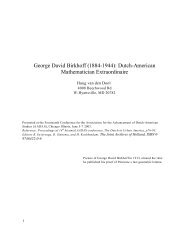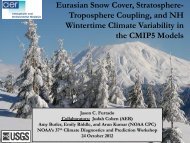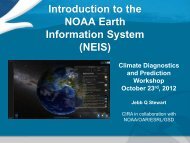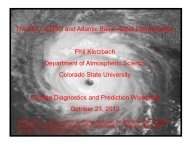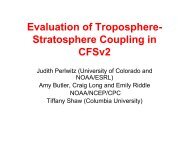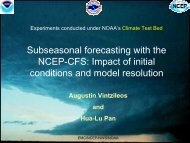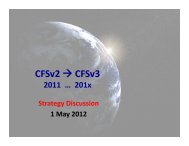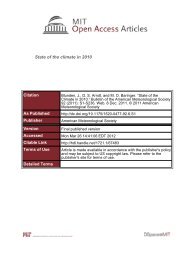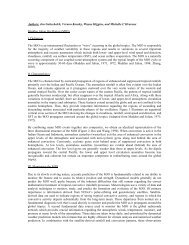Seasonality of the Pacific decadal oscillation - Climate Prediction ...
Seasonality of the Pacific decadal oscillation - Climate Prediction ...
Seasonality of the Pacific decadal oscillation - Climate Prediction ...
You also want an ePaper? Increase the reach of your titles
YUMPU automatically turns print PDFs into web optimized ePapers that Google loves.
SST response to <strong>the</strong> surface wind lead to <strong>the</strong> peak variability <strong>of</strong> <strong>the</strong> PDO in May and<br />
June.<br />
The results presented in this study suggest that <strong>the</strong> seasonality <strong>of</strong> <strong>the</strong> PDO does<br />
not just follow <strong>the</strong> seasonal change <strong>of</strong> <strong>the</strong> surface wind variability, but is also strongly<br />
modulated by <strong>the</strong> seasonal variation <strong>of</strong> <strong>the</strong> mean MLD. Strong surface wind variability<br />
in early spring is responsible for <strong>the</strong> concurrent increase <strong>of</strong> PDO variability. As a<br />
remarkable decrease in <strong>the</strong> MLD occurs from April to May, a relatively weak surface<br />
wind anomaly may induce a large ocean temperature anomaly over a shallower mixed<br />
layer due to <strong>the</strong> decoupling between <strong>the</strong> shallow mixed layer and <strong>the</strong> deeper ocean.<br />
Therefore, sufficient but not necessarily <strong>the</strong> strongest surface wind forcing and a very<br />
shallow MLD work toge<strong>the</strong>r and lead to <strong>the</strong> largest PDO variability in May and June.<br />
There are o<strong>the</strong>r processes that may affect <strong>the</strong> seasonality <strong>of</strong> <strong>the</strong> PDO, including<br />
<strong>the</strong> seasonal variations <strong>of</strong> solar radiation, clouds, oceanic entrainment, mean SST and<br />
associated mean SST gradient in <strong>the</strong> North <strong>Pacific</strong> (e.g., Norris et al. 1998; Park et al.<br />
2006; Chhak et al. 2009). The variability <strong>of</strong> tropical <strong>Pacific</strong> SST also influences <strong>the</strong> PDO<br />
(e.g., Evans et al. 2001). The contribution <strong>of</strong> ENSO to <strong>the</strong> variability <strong>of</strong> oceanic<br />
signature <strong>of</strong> <strong>the</strong> PDO, however, is difficult <strong>of</strong> untangle from <strong>the</strong> analysis <strong>of</strong> observations<br />
or <strong>the</strong> coupled simulations with tropical ENSO variations. Ano<strong>the</strong>r set <strong>of</strong> coupled model<br />
simulations where tropical SST variability is forced to follow <strong>the</strong> climatological seasonal<br />
cycle (and ENSO SST variability, and its influence on <strong>the</strong> extratropical SST variability<br />
via <strong>the</strong> atmospheric bridge mechanism is suppressed) may help isolate <strong>the</strong> contribution <strong>of</strong><br />
ENSO on <strong>the</strong> PDO related SST variations. Also, fur<strong>the</strong>r observational and modeling<br />
studies, including a quantitative analysis <strong>of</strong> mixed layer heat budget (e.g., Huang et al.<br />
17


